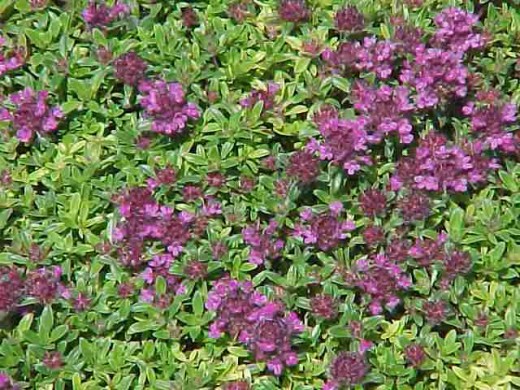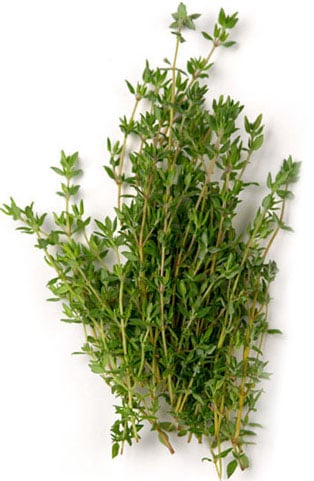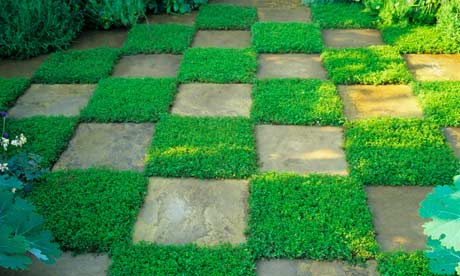Thyme Herb

The creeping thymes are amongst the loveliest of all plants with their tiny flowers and small leaves, the plants forming a carpet of color when in full bloom. The thymes may be divided into two main groups, the prostrate and creeping thymes and those of upright bushy habit like miniature shrubs. The former are members of T. serpyllus (Serpent like in habit) group whilst the latter are representatives of the T. citriodorus and T. nitidus groups and are valued for their culinary qualities.

Thyme in the kitchen
The thymes which are of upright, shrubby habit possesses individual aromatic qualities and are most valuable for stuffings and for flavoring meats. Natives of Mediterranean shores, they thymes prefer a sandy soil and like so many of the shrubby herbs, the plants grow well over limestone formations and are always happy in a soil which has a high lime content. Whilst the Grey-leaved thyme may be raised true from seed, sown in shallow drills under cloches or in frames during summer, the individual species and varieties are best propagated from cuttings. These should be removed with a heel and inserted into sandy soil either in the open or in a fame during summer. Alternatively, plants may be increased by root division, the outer portions of the clumps being most vigorous. Select a sunny position and a well drained soil and allow 15-18 inches between the plants. To prevent the plants becoming untidy, cut the shoots almost to ground level early in June and again at the end of August, and where growing commercially make up into bunches of a thickness that with fit between finger and thumb joined together.
For use in home, mixtures of various thymes will prove most appetizing though T. Herba barona, used in olden times to rub on Baron of Beef, hence its name, should always be used by itself, for it possesses a distinct caraway aroma. From Spain, came two thymes having a pungent aroma, T. micans which forms a little green mat and possesses a distinct pine aroma; and T. membranaceus, which has a similar perfume and bears quite large white flowers.
T. carnosus, which forms a compact, upright plant possesses a powerful aromatic fragrance, whilst T. fragrantissimus has attractive grey leaves which have a fresh orange pungency. From Sicily comes T. nitidus, also grey leaved and which has the same well known pungency as the Black or English thyme, T. vulgaris, of which there is also a golden leaf foam. There is also a French variety, having narrow grey leaves. But it is the Lemon scented thymes which are the most pleasing for their perfume is most refreshing. T. citriodorus, Silver Queen, is perhaps the best form, its leaves being of a lovely silver color. There is also a gold leaf form, aureus, the leaves taking on their golden colouring during early winter, for all the thymes are evergreen and may be planted about the rockery or rock gardens to give winter color. The well known culinary thymes grow about 8 inches high as they tend to form much old wood after 3-4 years, young plants should be grown on from cuttings to take their place or they should be divided frequently.

Growing Thyme
Like the chamomile, plants of T. serpyllus coccineus may be raised from seed. Its leaves are dark green, it blooms deepest crimson, and remaining colorful from June until late in August. When raised plants from seed, varieties will be more limited than wherer the plants are obtained vegetatively, many being very beautiful.
There are just about the same number of species of thyme as of the mint, almost thirty and as many as possible should be grown in all parts of the garden. They are the most charming of all plants and are extremely hardy and long lasting where the soil is light and well drained. Seed of a number of species may be sown in boxes of compost in early summer or in early winter, where they are allowed to remain exposed to the weather until early spring when the boxes are placed under glass. Germination will be rapid and the young plants may be transplanted to small pots where they remain until set out in autumn or early spring. The thymes with their woody rootstock resent transplanting after the seedling stage and should be grown on in 3 inch pots. They like a compost containing one third sand and a small quantity of well decayed manure.
The thymes may be readily raised from cuttings taken with a heel from the woody stems and when about 2 inches in length. They will quickly root in boxes, or around the sides of a pot, or planted in frames in a sandy compost. When rooted they may be transferred to individual pots from which they may be planted out at almost any time, though they seem to enjoy spring planting best. Named varieties from pots will cost about is od. Each.
There is a form of T. serpyllus coccineus which is more robust and bears larger and more deeply colored flowers. It is known as T. coccineus major and is a fine rockery plant though is not quite so prostrate as the ordinary form. Another, T. coccineus minus, is even more dwarf than the type. It bears rich pink flowers and grows only ½ inch tall. It is lovely for covering the sides of a trough. Almost as prostrate is the variety Annie Hall, which forms mats of fleshy pink flowers whilst Pink Chintz is of similar habit and bears mats of a beautiful shade of salmon pink. With T. coccineus, plant snowdrift, its pure white counterpart, or T. serpyllus Sandersi of prostrate havit which bears white flowers. Another lovely white form, T. serpyllus albus, has leaves of a paler green coloring than others.
Another creeping thyme is T. serpyllus lanuginosus, which has silvery leaves and which are as if covered with wool. Also having wolly leaves is T. Doeffleri, its carmine pink flowers, which are sweetly fragrant, being accumulated by wooly white foliage. T. micans is interesting in that it forms large gray-green mats, studded with attractive mauve blooms and carries a distinct aromatic pine fragrance. It is not quite as prostrate as T. serpyllus but may be planted with the creeping thymes, as may T. Lemon Curd, a hybrid which carries the real fragrance of lemons. It forms a tiny hummock.
Two more thymes of prostrate habit are T. odoratus and T. azoricus, both of which form bright green mats, possess a powerful fragrance and bear bright mauve flowers. Both are lovely plants for crazy paving or planting on top of a dry wall.
To plant between crazy paving, soil should be removed to accommodate the plant with its ball of soil as it is shaken from the pot. Where the plants have not been pot grown, the soil between the stones should be removed to be replaced by prepared compost of mixture of loam, sand and a little decayed manure into which the young plants are set out. This will provide the plants with a friable soil where the original soil may be heavy or not too well drained. Early spring is the best time to plant between crazy paving stones.
There are many other plants to use besides the herbs such as aubrieta, phlox, and lithospermum. The herbs do, however, enjoy being trodden upon and in this respect, the creeping mints should not be forgotten.








